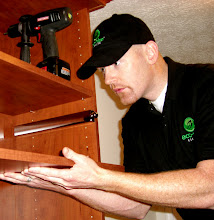
The second most used area in the house next to the kitchen, the office is a hub of household activity - home management tasks, kid's school stuff, and take-home work from your day job. It can also become reminiscent of your college dorm. Don't let clutter condemn your office. With these ideas, you can turn an overrun office into an organized, productive and peaceful place for working, web surfing, and budget planning.
Manage the details of your busy life at home or at work - from daily paperwork to annual plans and records. This artfully crafted space in cherry wood veneer signals success but knows how to get down to business. Drawer and door options conceal and reveal, while shelves display pieces that inspire.
Why crowd into a workspace built for one? Make room for multitasking: homework and bill-paying, web-shopping and budget planning. With cabinets and shelves, walls become well-organized storage for books, binders, albums, crafts and more. The large worksurface supports your family's online and on-paper activities.
Consider these tips for an organized office:
Designate your primary work zone a sacred space. Clutter can dull your focus and wrinkle your brow. Keep only your frequently used supplies on the desktop. You'll be surprised how a clean desk policy can de-stress even bill-paying.
Make room for what you're working on right now. At an arm's length, stow pens, stapler, clips, and the few references you use daily so you won't have to get up to rummage for them when you're on a roll.
Devote shelf space for inspirational display. Whether it's family photos, travel memorabilia or your kid's latest art project, plan on a specific place for special items that bring a smile to your day.
Prepare a pleasing visual aid to help keep you on task. Use a chalk or marker board to jot down your running list of to-dos, your best ideas, upcoming events, and reminders to other family members.
Set up spaces to suit your work style. In a ready-access area designated for items used frequently, clip or prop up pieces you need now to get the job done. In an archival space use file cabinets or deep drawers to file product warranties, old tax returns, and financial folders.

Wow — thank you for the inspiration and great ideas! I just moved, and finally have a closet large enough to transform into the home office of my dreams…
ReplyDeletecloset design Chicago